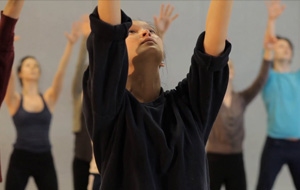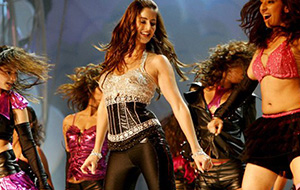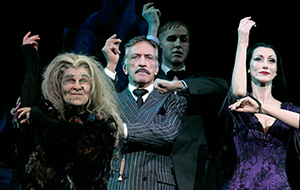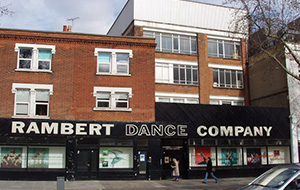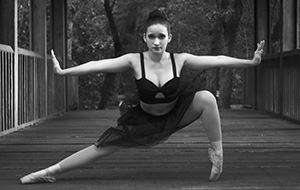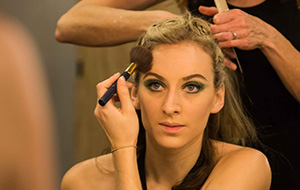 Ingrid Gow was born in Randwick, Sydney in 1987. She knew from the age of four that she wanted to grow up to be a ballerina. Her training began at Academy Ballet in Sydney and continued at New Zealand School of Dance. In 2007 Ingrid successfully auditioned for Royal New Zealand Ballet, where she danced for three years. Ingrid joined The Australian Ballet in 2010 and was promoted to coryphée in 2013.
Ingrid Gow was born in Randwick, Sydney in 1987. She knew from the age of four that she wanted to grow up to be a ballerina. Her training began at Academy Ballet in Sydney and continued at New Zealand School of Dance. In 2007 Ingrid successfully auditioned for Royal New Zealand Ballet, where she danced for three years. Ingrid joined The Australian Ballet in 2010 and was promoted to coryphée in 2013.
Ingrid’s repertoire includes Princess Royal in Graeme Murphy’s Swan Lake 2015, Frederick Ashton’s Symphonic Variations 2015, Jiří Kylián’s Petite Mort 2014 and Bella Figura 2013, Skinny Stepsister in Alexei Ratmansky’s Cinderella 2016, 2015, 2013 and Lady Capulet in Graeme Murphy’s Romeo & Juliet 2011.
You may not know that Ingrid also loves reading and adding to her high heel collection!
The Australian Ballet will be screened in the UK for the first time by CinemaLive. The Fairy Tale Series – a series of three world premieres – will be screened across the UK on three nights only: The Sleeping Beauty on 4 October, Cinderella on 23 November and Coppelia on 19 April 2017.
—
Did you always want to dance?
I started ballet at four years old and once I had had my first experience on stage at the end of year concert I was hooked, with classes in jazz, contemporary, character and a little bit of tap. Once I hit about 14 years I started thinking of ballet as a career option and from then on everything I did was to help secure that path.
Where did you train and what was it like?
I started my training at Academy Ballet in Sydney and studied there until I was 16. It was my second home for all of those years, and I have made lifelong friends with the students and the teachers. At 16, I moved to New Zealand to complete three years of full time dance at New Zealand School of Dance in Wellington and graduated with a National Diploma in Dance Performance. Those three years helped me to realise that the hard work does pay off.
How did you come to be part of The Australian Ballet?
I joined The Australian Ballet in 2010 after three years with Royal New Zealand Ballet. I had lived in New Zealand for six years to study and work, and I wanted to come home and spend more time with my family. I grew up watching The Australian Ballet perform in Sydney at the Opera House and it was always where I hoped I would continue my career.
Who or what inspires you?
My fellow dancers inspire me every day. Talent only gets you so far. It’s the passion and hard work I see in the rehearsals and performances that makes me proud to be a part of The Australian Ballet.
 What has been the most memorable moment of your performing career to date?
What has been the most memorable moment of your performing career to date?
My most memorable time was the creation of Alexei Ratmansky’s Cinderella. Watching him develop the characters of the Step family was the most fun I have ever had in the studio and we felt that we could really make them our own. Sometimes I’m not sure if I’m truly acting the role of the Skinny Stepsister or if it has become an alter ego!
What has been the most challenging?
The most challenging part for me is finding the balance between my professional and personal life. We give so much of ourselves in the day to day activities we don’t always give the time for the recovery of the body as well as the mind.
What is a day in your life like now?
At the moment we are rehearsing for the season of Nijinsky, so after a morning ballet class we rehearse all day in the studio until 6:30pm, with a break of about an hour and a half throughout the day. If I have an extra break from rehearsal I’ll be in the gym and after work it’s home for dinner. At the weekend I will try to be more social and spend time with friends, but if I have two days off work, one of them will involve a quick trip to the gym to get my blood pumping.
What is the best thing about the dance and performing arts industry?
I have always felt that dance is selfish in a way, I do it for myself and no one else, quite simply it feels good and makes me happy and I want to do it every day. I can’t imagine feeling like that about any other kind of work. However, I also love that it creates conversation and discussion. It’s designed for the audience to feel enjoyment, love, hate, and to be challenged. It is art.
What would you like to change?
I wish there was more of an understanding from the outside world of what goes into making dance a career. The Australian Ballet is part of that change with several behind the scenes activities and a large online presence. We are slowly infiltrating the masses.
What would be your advice to an aspiring dancer?
Look after your mental health as it’s just as important as a healthy body.
What’s next for you?
I hope to continue to enjoy my career here with The Australian Ballet for as long as possible. I’m not sure what the next phase of my life will entail, but I’m sure that it will be just as satisfying.
 The entertainment group Global Creatures, the co-producers of Baz Luhrmann’s Strictly Ballroom at the West Yorkshire Playhouse, has confirmed it will bring Luhrmann’s Moulin Rouge! to the stage. Another hit production from Luhrmann, Moulin Rouge! tells the story of a young poet and writer, named Christian, who falls in love with the star of the famous Moulin Rouge cabaret show, the actress and courtesan Satine. The story uses the musical setting of the Montmartre Quarter of Paris, France.
The entertainment group Global Creatures, the co-producers of Baz Luhrmann’s Strictly Ballroom at the West Yorkshire Playhouse, has confirmed it will bring Luhrmann’s Moulin Rouge! to the stage. Another hit production from Luhrmann, Moulin Rouge! tells the story of a young poet and writer, named Christian, who falls in love with the star of the famous Moulin Rouge cabaret show, the actress and courtesan Satine. The story uses the musical setting of the Montmartre Quarter of Paris, France.

